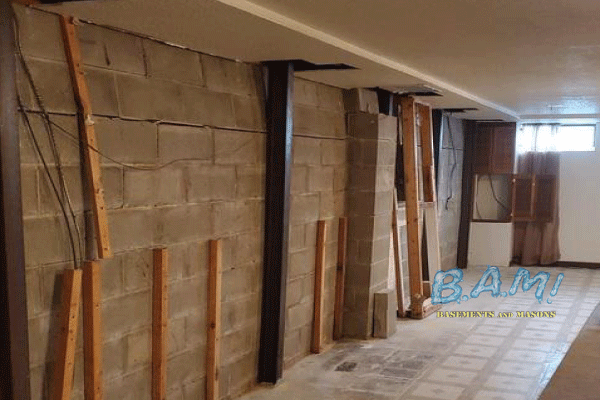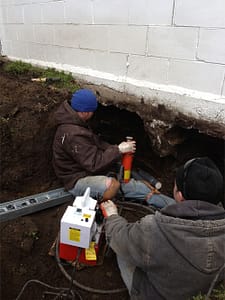8 Easy Facts About Best Basement Waterproofing Explained
8 Easy Facts About Best Basement Waterproofing Explained
Blog Article
The Ultimate Guide To Best Basement Waterproofing
Table of ContentsBest Basement Waterproofing Fundamentals ExplainedBest Basement Waterproofing for BeginnersMore About Best Basement WaterproofingExcitement About Best Basement WaterproofingThings about Best Basement Waterproofing
AdvantaClean's qualified experts and service technicians will certainly find the water source. If wall surface or piece fractures are present, we will inject polyurethane and epoxies into the cracks and seal the concession, protecting against more moisture from getting in.
If there's condensation on the exterior of the foil, you have high humidity in your cellar. Fix it with a mobile room dehumidifier or a whole-house humidifier system rather than waterproofing products. If the aluminum foil has condensation on the inside surface area (alongside the wall surface), the dirt around your residence may be naturally damp from a high water table or poor dirt drainage.
You can waterproof simply your indoor walls, which might resolve the issue. Or you can waterproof your outside walls, which is a far better bet however even more costly. Right here's the scoop on the different kinds: These thick finishings are cement-like. Once they dry out, they adhere permanently to concrete and masonry walls (Best Basement Waterproofing).
All About Best Basement Waterproofing
Concrete water-proof finishings can not be used to formerly repainted surface areas; inspect the label. Known as densifiers, they are suitable just for walls that haven't been repainted or secured.
However you clean, roll, or spray it on far more heavily one gallon covers just 75 square feet, not the 300 square feet common with common paint. Water-proof paint is great for DIY application. You can use it over repainted surface areas, and paint over it once it's treated (one gallon expenses $37).
It can cost $10,000 to $15,000, depending on the work required. Exterior waterproofing entails digging deep into all over the house to the complete depth of the structure wall surfaces, then mounting a water resistant finishing or membrane covered by water drainage panels. The panels supply a simple course for water to stream Click This Link down to an outside French drain at the base of your foundation.
We've all been captured in a storm without umbrella or raincoat (Best Basement Waterproofing). And it's always a recipe for calamity: everything's wet, your hairdo is ruined, and things are obtaining musty. A cellar without waterproofing is kind of like that. Minus the spoiled hairdo part. Your basement does not intend to go through a downpour without appropriate defense equally as long as you do not intend to.
Rumored Buzz on Best Basement Waterproofing
Yet if you have actually done your research, you would certainly understand there are 2 types of waterproofing: interior and exterior. It can obtain perplexing what they both mean, which one's a far better financial investment, and what will actually keep the water out. Don't worry, we assembled this blog to quickly specify both approaches for you and review the pros and disadvantages of each.
Outside waterproofing is a waterproofing technique that involves securing your home from see it here the exterior. The structure walls are after that cleaned up, sealed, and covered with a water-proof membrane layer or sealant.

6 Easy Facts About Best Basement Waterproofing Explained
It's a much more engaged procedure that requires digging up your lawn, which is pricey and taxing. Exterior waterproofing entails getting rid of whatever surrounding your home, consisting of decks, driveways, walkways, landscaping, air conditioner units, decks, and so forth. If any of the work was done improperly and water is still entering your cellar, there isn't much you can do to deal with or repair it.
Interior cellar waterproofing involves waterproofing from the inside. Any water that leaks into your basement is rerouted prior to it touches your flooring. It's sort of like putting on a raincoat under your clothes. It includes two things: a water drainage track and a sump pump. go It functions by securing the within your cellar wall surfaces and floorings so water that tries to go into is funnelled out via a sump pump.
It's an effective method to waterproof your basement. The downside of indoor cellar waterproofing primarily has to do with the installment procedure.
What Does Best Basement Waterproofing Do?
In verdict, exterior and indoor basement waterproofing are both reliable approaches of securing your home from water damage. Outside waterproofing creates an obstacle that prevents water from entering your home, while indoor waterproofing redirects water that does enter your home. And it is essential to keep in mind that exterior waterproofing is an expensive and turbulent installation procedure when compared to indoor waterproofing.
Whichever technique you choose, make certain you choose a reliable and reliable specialist for the job. Both approaches require seasoned workers to handle the task. If you have any concerns about cellar waterproofing, please get to out to us. And if you're in our solution area and have water in your cellar, call us for a complimentary, no-obligation home inspection.
You can complete our kind here, start a conversation in the lower right-hand edge, or call us at 1-800-827-0702.
Report this page